Dual CANbus monitor and instrumentation cluster
Eagle Schematic and Board design
/media/uploads/TickTock/canaryr5.zip
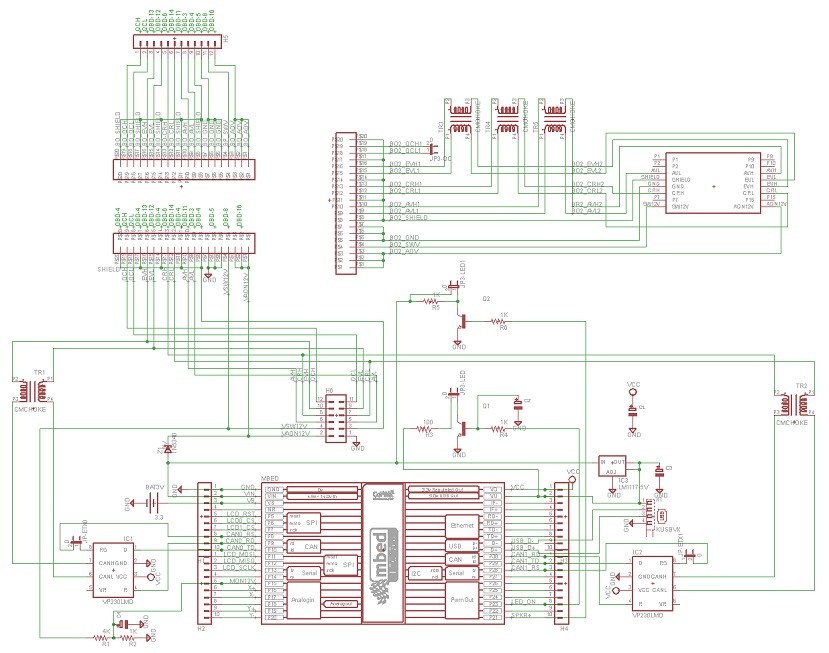
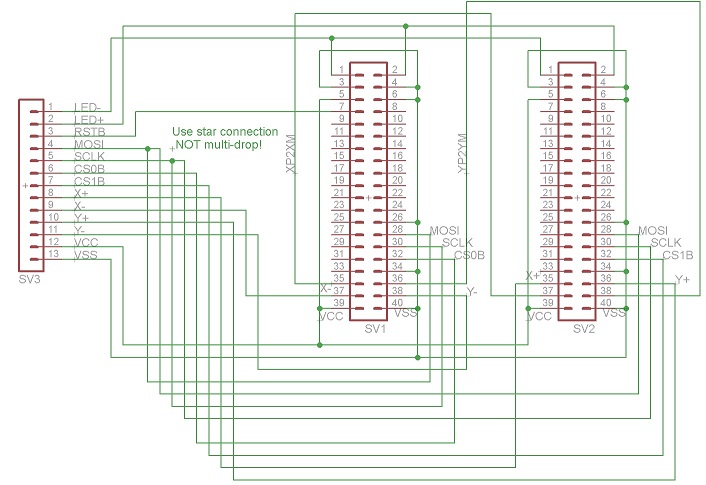
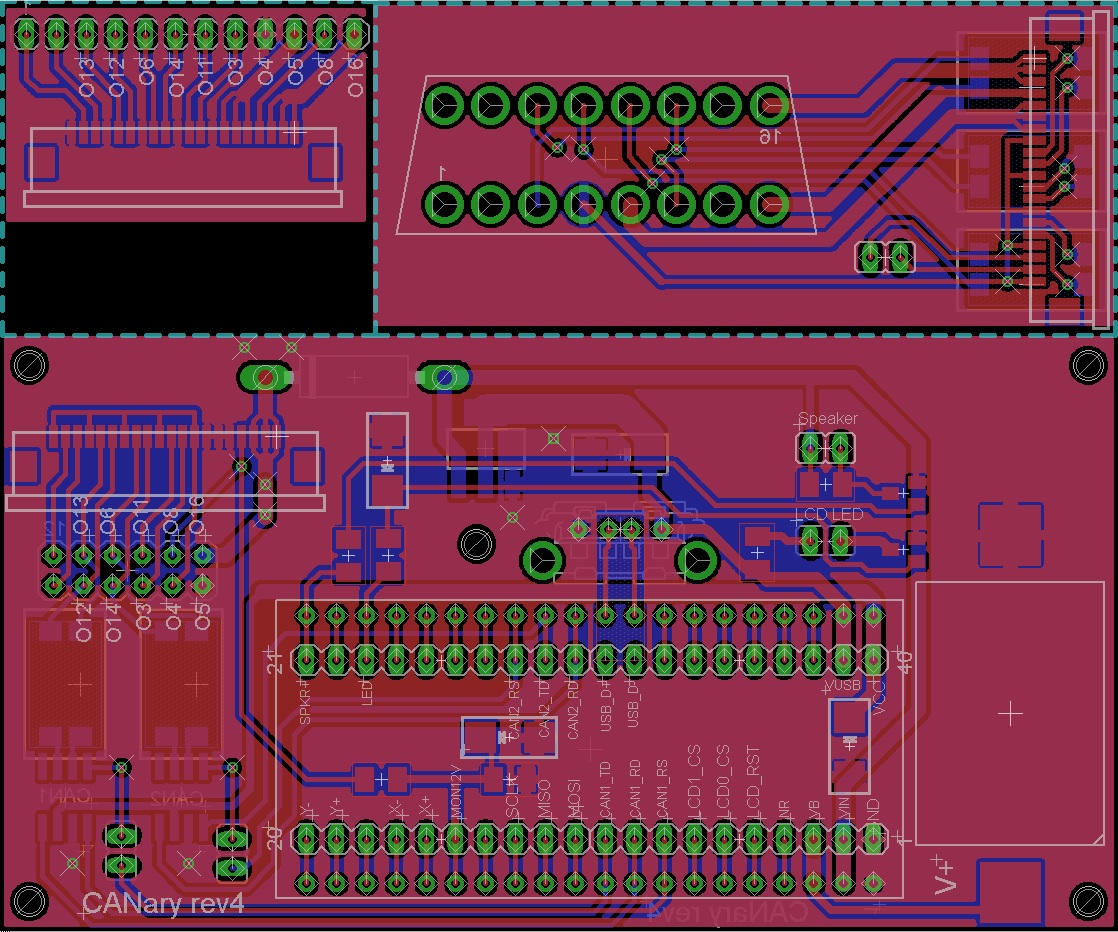
Parts List
Assembly
1) LCD Displays
I found ribbon cable is a nice way to organize the wires to the displays. You'll need 12 conductors and I connected them in the following order:
| 1 | LED+ |
| 2 | LED- |
| 3 | RSTB |
| 4 | MOSI |
| 5 | SCLK |
| 6 | CSB |
| 7 | X+ |
| 8 | X- |
| 9 | Y+ |
| 10 | Y- |
| 11 | VDD |
| 12 | GND |
First I connected all the GND connections (IM0, IM1, IM3, & 2 GND). Do not connect the bottom GND until you have the ribbon cable connected. After making all the ribbon cable connections (connecting the GND of the ribbon cable to the bottom GND pad), solder the GND bar from the previous step to the back of the bottom GND connection. Finally, make a connection from the back side 3.3V pin to IM2. Take a break and repeat for the second display.
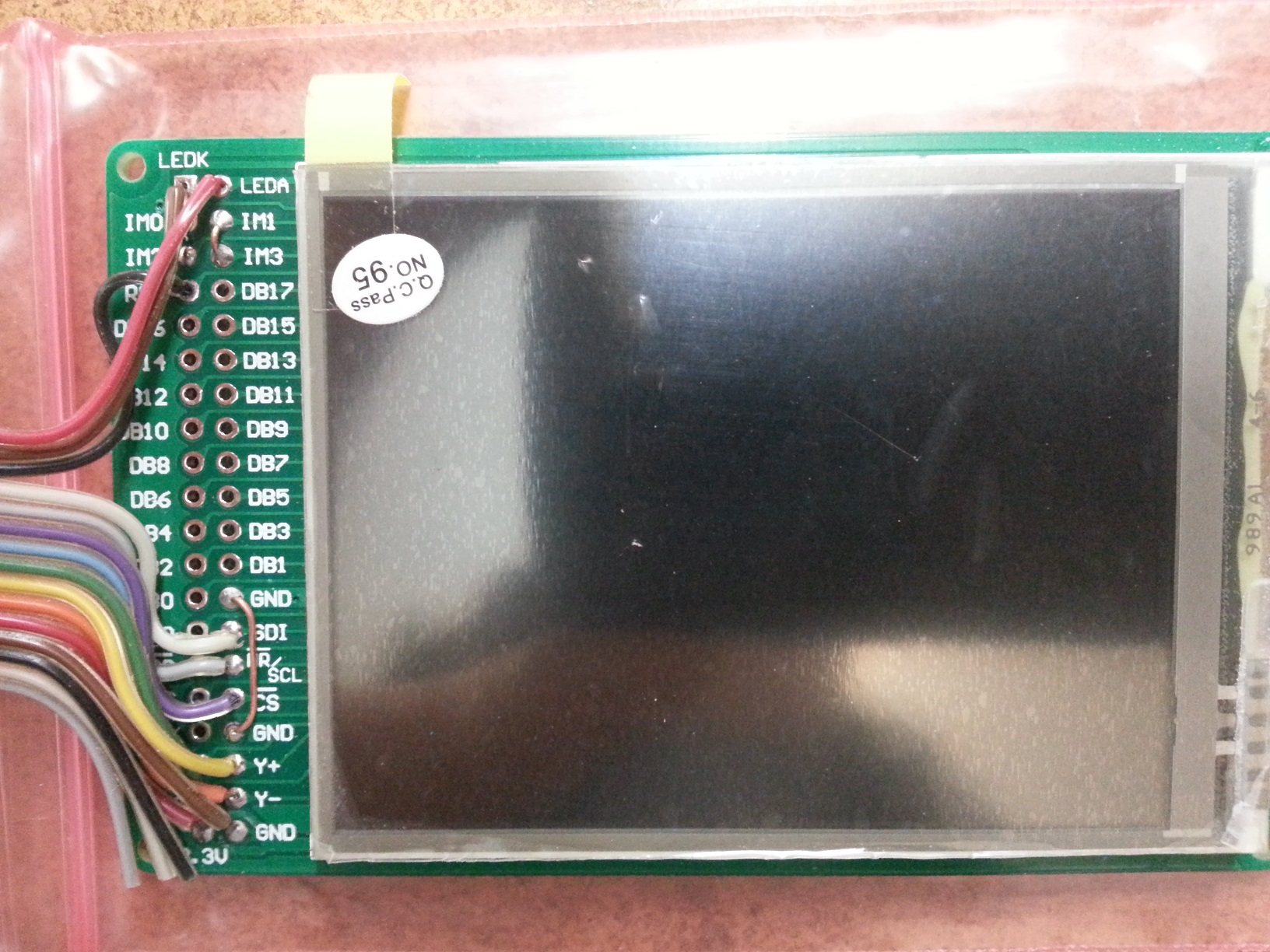
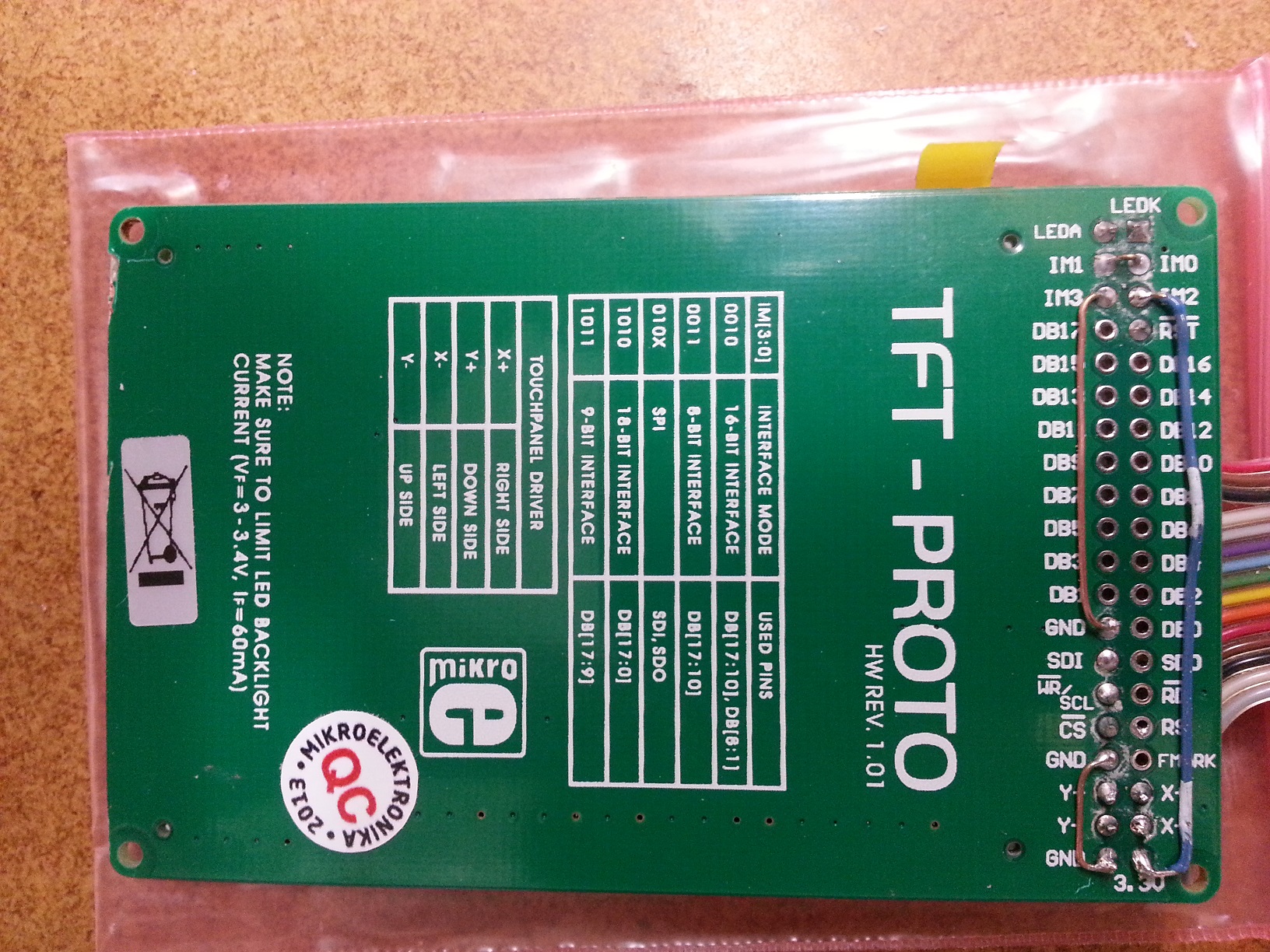 Once the two displays are complete combine all wires except CS0, CS1, X+, X-, Y+, and Y-. Connect X- of the left display to X+ of the right. Similarly connect Y- of the left display to Y+ of the right. Insulate any exposed wires.
Once the two displays are complete combine all wires except CS0, CS1, X+, X-, Y+, and Y-. Connect X- of the left display to X+ of the right. Similarly connect Y- of the left display to Y+ of the right. Insulate any exposed wires.
2) PCB
Refer to the schematics to place all the components on the board. If you plan to install into the CANary 3D enclosure, DO NOT install the battery holder or the socket for the mbed and, instead, connect two wires to the VB and GND pads nearby. You will have to install the battery holder against the back wall to avoid interfering with the right-hand display and the mbed will have to be directly soldered. I have not found a socket with a low enough profile to fit in the space provided (depth of enclosure is limited by the space behind the center console). Also, I recommend keeping as much lead as possible on the Zener diode (bending it as shown to clear the back wall). Although it is operating well within parameters, the Zener gets quite hot during extended operation and the leads help dissipate the heat and keep it away from the PCB and other components.
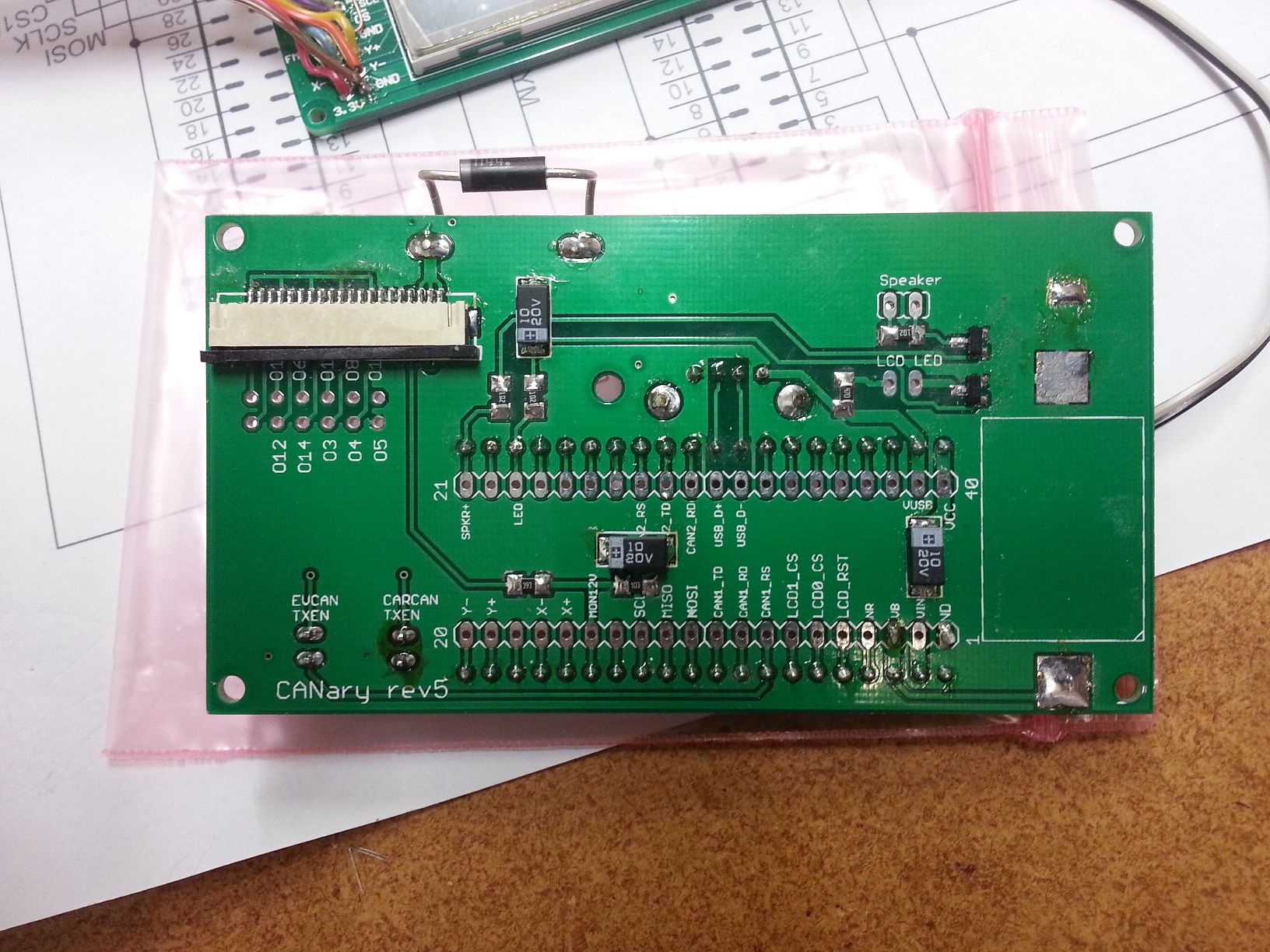
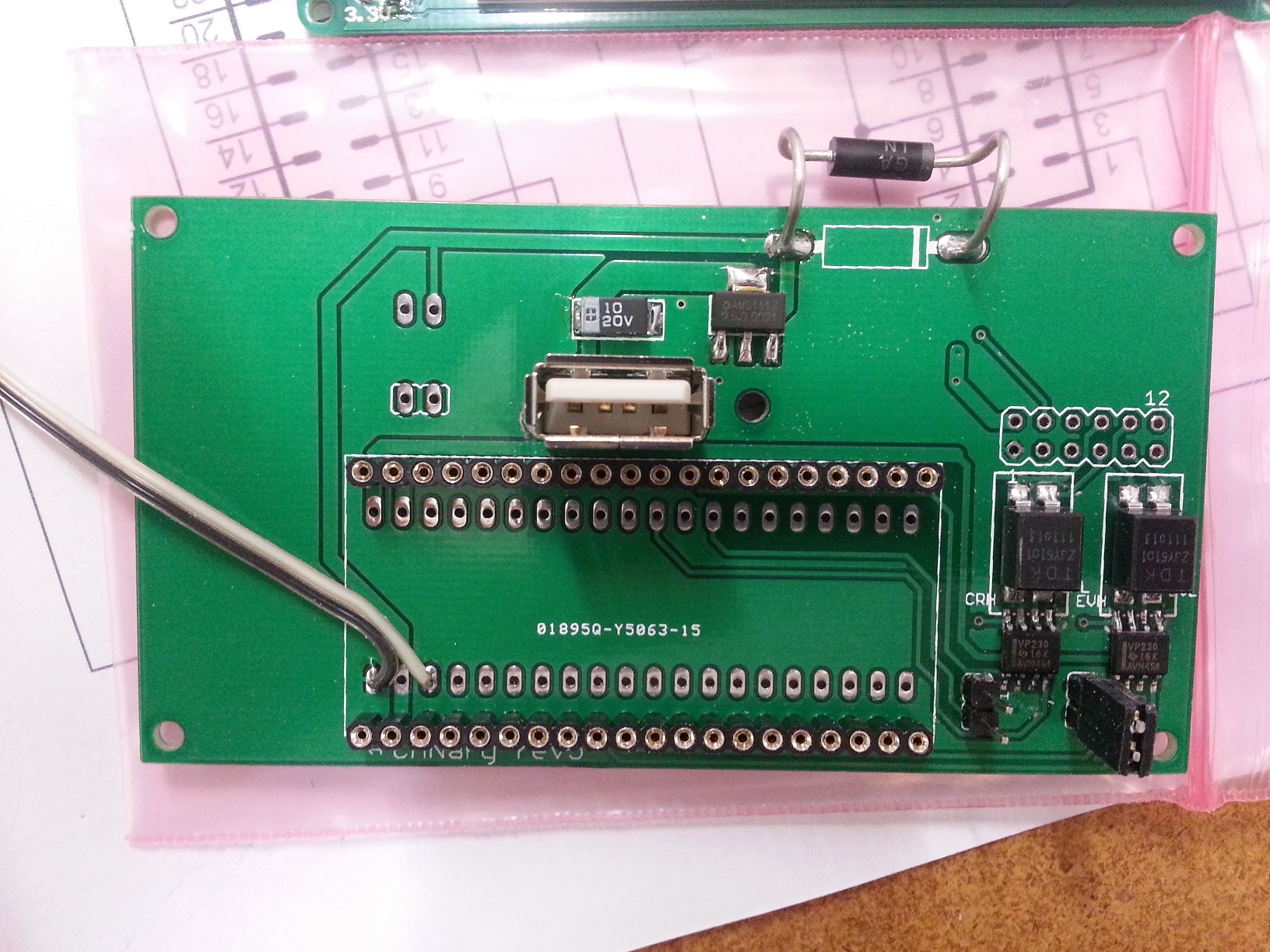
Once the PCB is populated, solder the LCDs to the PCB. CS0 connects to the right display and CS1 connects to the left.
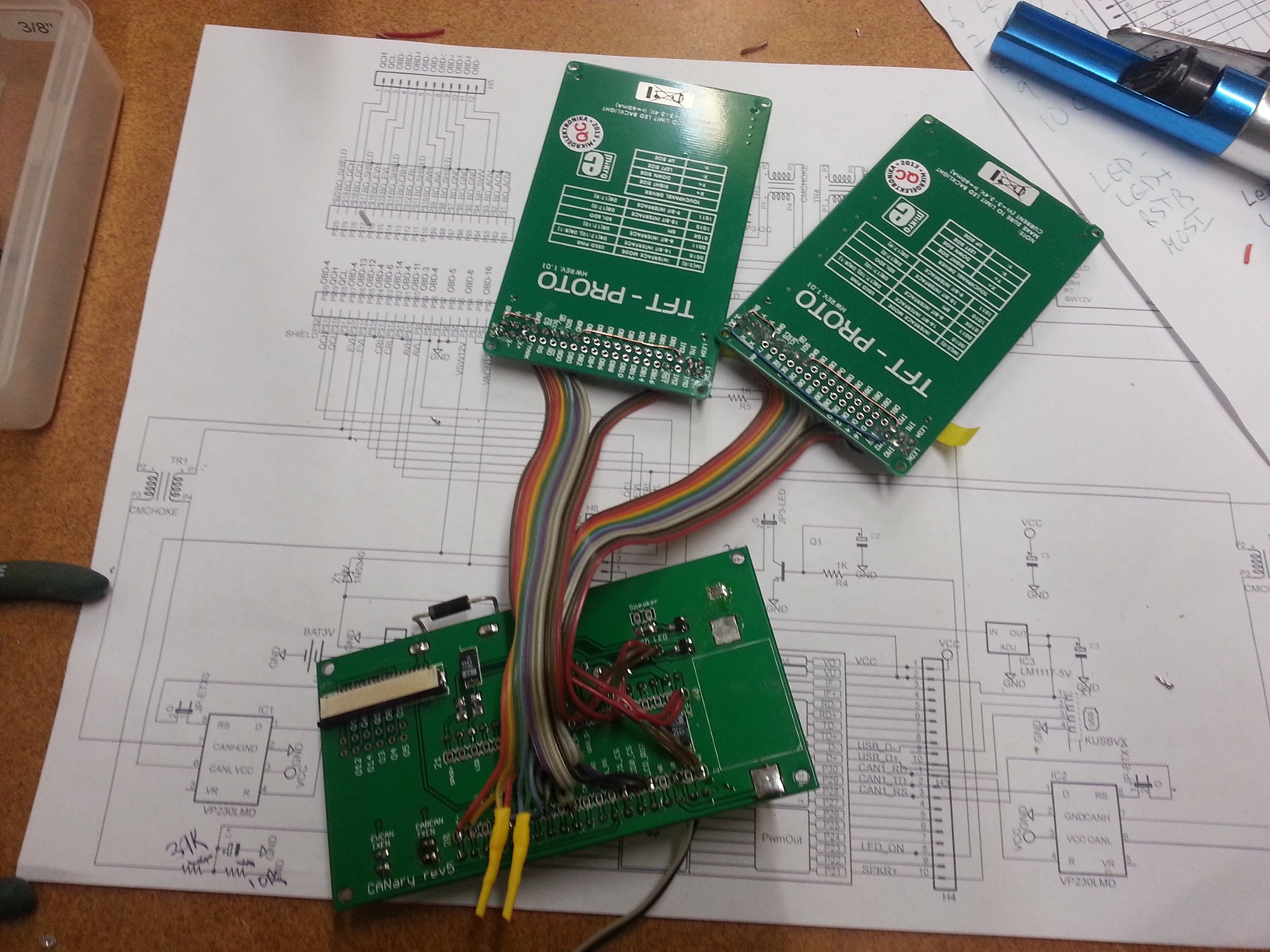
3) Testing
| 1) | First step is to buzz out all connections from the LCDs to the pins in the main board |
| 2) | Next check the touch screen connections. On the main board, place an Ohm meter across X+ and X-. You should read 700 Ohms. Repeat for Y+ and Y-. Then test the resistance from X+ to Y+. With nothing touching the screens, it should read >100K Ohms and <1K when touching either screen. |
| 3) | When all connections are checked, solder in the mbed. Download and install the touch2 program http://mbed.org/users/TickTock/code/touch2/ to test the basic operation of the mbed and touch screens. |
| tips: | |
| Touch screen is sensitive - excess flux on X+,X-,Y+,Y- connection on mbed can result in flakey operation | |
| If touch is not working, double-check the LCD0_CS and LCD1_CS are not swapped. LCD0_CS must connect to the CS of the LCD that has X- & Y- connected to the mbed. LCD1_CS must connect to the CS of the LCD that has X+ & Y+ connected to the mbed. | |
| 4) | Once touch2 works, it is time to connect to the OBD connector. I highly recommend double checking all connections from the OBD to the PCB with the cable in place before connecting to the Leaf. Buzz out all the pins in the OBS to make sure none are shorting to each other, Check that the 12V goes to the Zener (and nothing else) and the switched 12V to the resistor divider (and nothing else). Test the ground connection properly connects to ground and nothing else. |
| 5) | Once you are confident there are no shorts or wrong connections from the OBD connector, take a deep breath and plug it into your leaf. Touch2 program should come up and function. Unplug and install the latest CANary firmware. Test all features before installing into the enclosure (gids, cellpair, menu system, logging) since installing and removing from the enclosure is a PITA. |
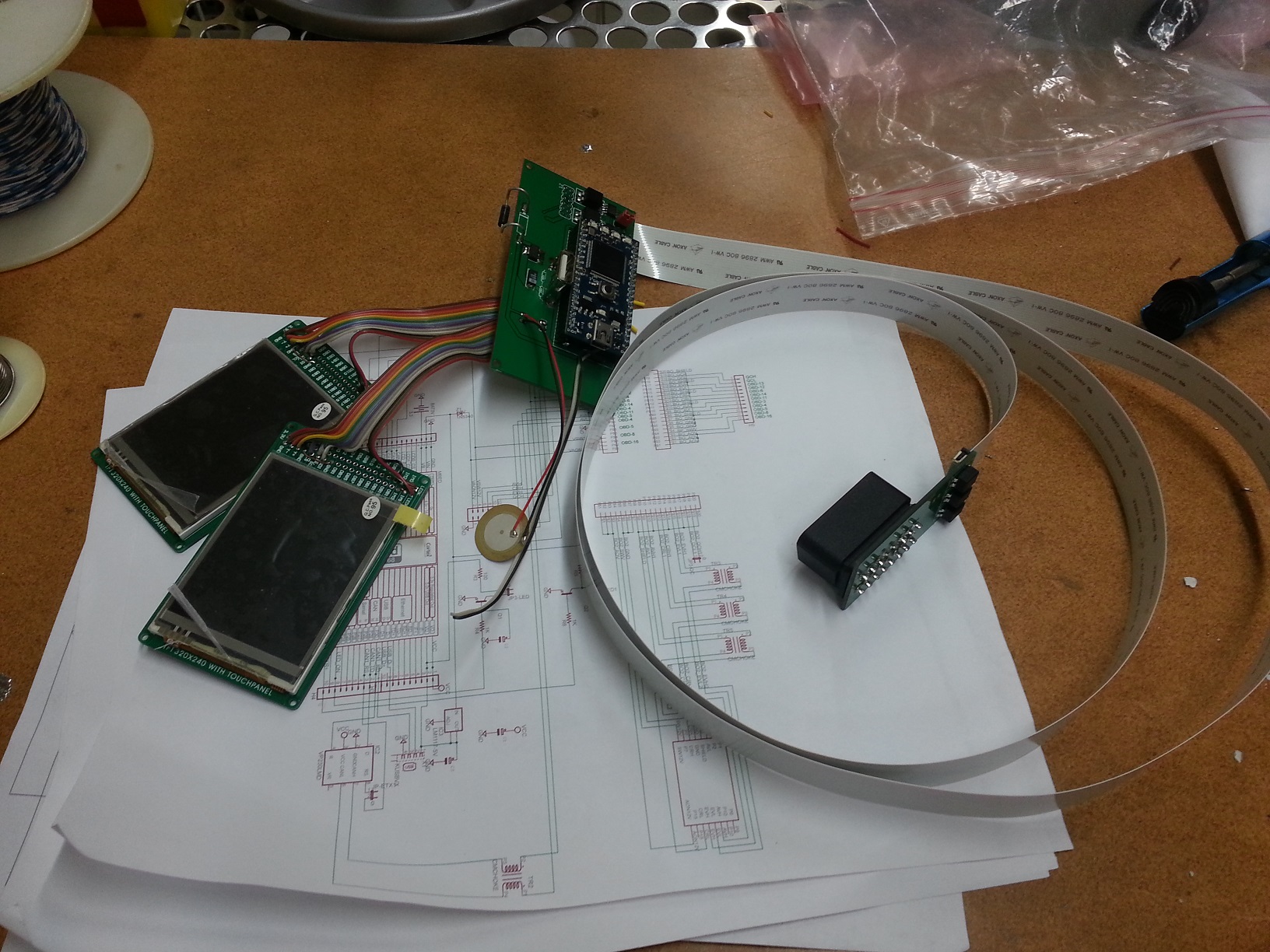
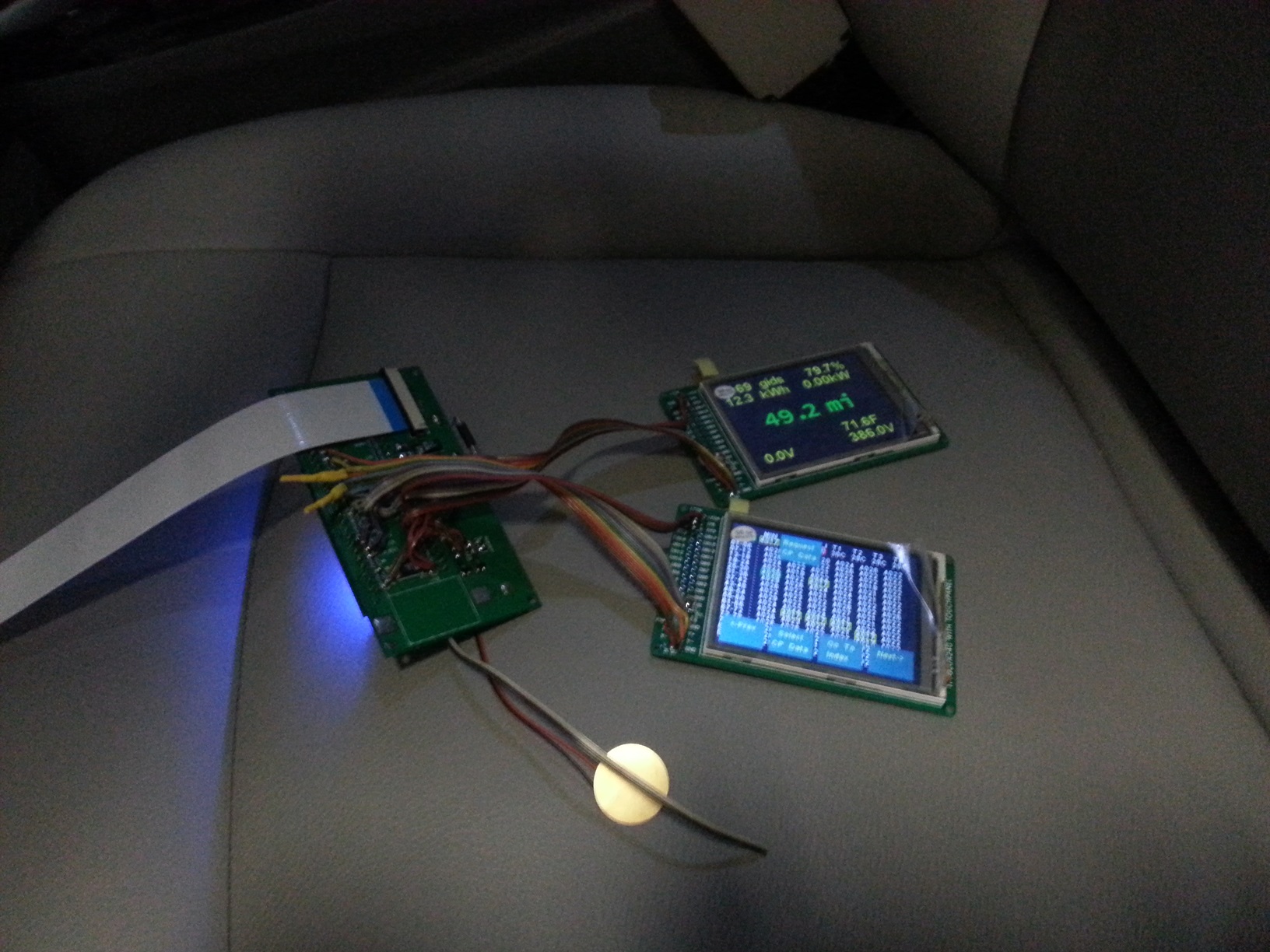
4) Enclosure
The 3D printer leaves a lot of powder behind - I used a strong spray of water to get it out of all the cracks. The enclosure comes with a rather rough finish. I recommend convincing yourself you like it, then simply lightly sand then paint before assembly. Sanding is very difficult - the nylon is very nicely fused and doesn't want to sand. I tried sandblasting and that didn't work either. I had some limited success with filler and then sanding, but only on the outside - it is too difficult to sand the face.
5) Final Assembly
Diff: utility.cpp
- Revision:
- 83:52b1f330a62d
- Parent:
- 80:cf009a64eedd
- Child:
- 85:5c27e88b3fbe
--- a/utility.cpp Tue Apr 16 21:55:41 2013 +0000
+++ b/utility.cpp Wed Apr 17 11:48:10 2013 +0000
@@ -38,272 +38,122 @@
return ((isecs<<10)+msec) ; // return the two byte time stamp
}
-//------------------------------------
-// gg - logcan
void logCan (char mType, CANMessage canRXmsg) {
- // re-arranged to put static first
- static unsigned char ii = 0;
- static unsigned char lasti = 0; // indexindex
+ char sTemp[40];
+ unsigned short ts = getTimeStamp();
+ static unsigned char ii = 0, lasti = 0; // indexindex
+ unsigned char changed,i;
static unsigned char bdi=0;
- static signed short imotorRPM = 0;
- static unsigned short nLost = 0; // gg - overrun
-
- char sTemp[40];
- unsigned char changed,i;
- unsigned char ij;
signed short packV;
signed short packA;
+ static signed short imotorRPM = 0;
signed long imWs_x4;
- unsigned short ts = getTimeStamp();
secsNoMsg=0; // reset deadman switch
-
if(logOpen){
if(canRXmsg.id>0) {
- // check to see if buffer is already full (read - write) = 1
- // actually the last buffer location cannot be used because then
- // the buffer would look empty after writePointer++
-
- //if (((writePointer+maxBufLen-readPointer)%maxBufLen)>(maxBufLen/16)) // modulo is slow?
-
- // maxBufLen = 512, so pointers are 0 through 511
- if( (readPointer - writePointer) == 1 || (writePointer - readPointer) == (maxBufLen - 1)) {
- // the buffer is "full", so Lose this message
-
- // point to the last-stored message
- int tempWritePointer = writePointer - 1 ;
- if( tempWritePointer == -1 ) tempWritePointer = maxBufLen - 1;
- char strLost[9] ;
-
- if( nLost == 0 ) {
- // this is the first message lost
- // and we must overwrite the last message with an FFE comment message
- // So, there will be two messages lost as the comment message is laid in.
- nLost = 2;
- sprintf(strLost,"%s","Lost0002"); // indicate two messages lost
-
- // overlay the last message with a "Lost0002" comment
- writeBuffer[tempWritePointer][0]=0;
- writeBuffer[tempWritePointer][1]=(ts&0xff00)>>8; // Time Stamp (2 bytes_
- writeBuffer[tempWritePointer][2]=(ts&0x00ff);
- writeBuffer[tempWritePointer][3]=0xfe; // MsgID, low byte
- writeBuffer[tempWritePointer][4]=0xff; // Len nibble, and MsgID high nibble
-
- for(i=5;i<13;i++){
- writeBuffer[tempWritePointer][i]= strLost[i-5];
- }
- } else {
- // increment the loat counter
- nLost += 1;
-
- // lay the new count into the comment
- sprintf(strLost,"%04d",nLost);
- for(i=9;i<13;i++){
- writeBuffer[tempWritePointer][i]= strLost[i-9];
- }
- }
- } else {
- // is room to insert the message
- // get it inserted quickly
- writeBuffer[writePointer][0]=mType;
- writeBuffer[writePointer][1]=(ts&0xff00)>>8; // Time Stamp (2 bytes_
- writeBuffer[writePointer][2]=(ts&0x00ff);
- writeBuffer[writePointer][3]=canRXmsg.id&0xff; // MsgID, low byte
- writeBuffer[writePointer][4]=(canRXmsg.id>>8)+(canRXmsg.len<<4); // Len nibble, and MsgID high nibble
- for(i=5;i<13;i++){ // Is there a better way to do this? (writeBuffer[writePointer][i]=canRXmsg.data?)
- writeBuffer[writePointer][i]=canRXmsg.data[i-5];
- }
- //--------------
- // force unused data bytes to FF for CAN-Do compatibility - gg - force FF
- if(canRXmsg.len < 8){
- for(i=canRXmsg.len; i<8; i++) {
- writeBuffer[writePointer][i+5]=0xFF;
- }
- }
- //--------------
- // note, this is not protected from the interrupt
- // due to the nLost code above, this no longer
- // overflows to writePointer = readPointer
- // which would make the buffer look empty
- if (++writePointer >= maxBufLen) {
- writePointer = 0;
- led3 = !led3;
- }
- //--------------
- // log a local message if we had lost messages. gg - logcan
- if( nLost > 0 ) {
- // We previously lost messages that did not get into the buffer
- sprintf(sTemp,"-- Write Buffer Lost [%d]\n", nLost);
- logMsg(sTemp); // write buffer overrun
- spkr.beep(500,0.25);
-
- nLost = 0 ;
- }
- //--------------
+ writeBuffer[writePointer][0]=mType;
+ writeBuffer[writePointer][1]=(ts&0xff00)>>8;
+ writeBuffer[writePointer][2]=(ts&0x00ff);
+ writeBuffer[writePointer][3]=canRXmsg.id&0xff;
+ writeBuffer[writePointer][4]=(canRXmsg.id>>8)+(canRXmsg.len<<4);
+ for(i=5;i<13;i++){ // Is there a better way to do this? (writeBuffer[writePointer][i]=canRXmsg.data?)
+ writeBuffer[writePointer][i]=canRXmsg.data[i-5];
+ }
+ if (++writePointer >= maxBufLen) {
+ writePointer = 0;
+ led3 = !led3;
+ }
+ if (writePointer==readPointer) {
+ // Just overwrote an entry that hasn't been sent to thumbdrive
+ sprintf(sTemp,"Write buffer overrun.\n");
+ logMsg(sTemp); // write buffer overrun
+ spkr.beep(500,0.25);
}
}
}
-
- //-------------------------------
- // Some MsgIDS are FFF and FFE, but this array only holds 0 to 7FF
- // so, only remember messages 7FF or less - gg - logging bug
- if( canRXmsg.id < 0x800 ) {
- // message is 7FF or less - gg - logging bug
-
- // Check if this MsgID has an associated ii entry
- if(indexLastMsg[canRXmsg.id]==0) {
- // no ii entry associated with this MsgID
-
- // BUG: but ii = 0 is a valid entry after this wraps
- //ii=ii<99?ii+1:0;
- //ii=ii<99?ii+1:1; // FIX: reserve ii = 0 as the "invalid, not used, entry
-
- if(ii<99) {
- // unused entries are available
- ii += 1; // use next unused entry
-
- // sever previous usage, if any
- //if( iiUsedBy[ii] != 0 ) indexLastMsg[iiUsedBy[ii]]=0;
-
- // keep track of what MsgID is using this ii entry
- //iiUsedBy[ii]=canRXmsg.id; // future
-
- indexLastMsg[canRXmsg.id]=ii; // Create MsgID linkage for first message
-
- // update the entry's data
- lastMsg[ii]=canRXmsg; //Store in table
-
- changed = 0xff ; // all bytes are new, so all changed
- msgChanged[ii]=changed;
-
- } else {
- // no more available unused entries
- // so just ignore this MsgID for now
- // ii = 1; // start to re-use entries
-
- // BUG: after this wraps to re-use the ii's, the old MsgID
- // that was using this ii needs to be invalidated
- //indexLastMsg[iiUsedBy[ii]]=0; // invalidate ii entry for old MsgID
- }
- } else {
- // there was an old entry for this MsgID to compare to for changes
- ij = indexLastMsg[canRXmsg.id] ;
-
- // compare the old message with the new one to make the data-changed flags
- // BUG?: why do this only if viewing the changedScreen?
- if(dMode[0]==changedScreen||dMode[1]==changedScreen){
-
- changed=msgChanged[ij]; // why get the old changed bits
- // what clears the changed bits, dislaying them on the changedScreen?
-
- // compare the 8 old and new data bytes for changes
- for(i=0;i<8;i++){
- if(lastMsg[ij].data[i]!=canRXmsg.data[i]){
- changed |= 1<<i;
- }
+ if(canRXmsg.id<0x800){ // Block FFE and FFF messages
+ if(indexLastMsg[canRXmsg.id]==0) { //Check if no entry
+ ii=ii<99?ii+1:0; // Should never wrap - less than 100 different messages ever used
+ indexLastMsg[canRXmsg.id]=ii; //Create entry if first message
+ }
+ if(dMode[0]==changedScreen||dMode[1]==changedScreen){
+ changed=msgChanged[indexLastMsg[canRXmsg.id]];
+ for(i=0;i<8;i++){
+ if(lastMsg[indexLastMsg[canRXmsg.id]].data[i]!=canRXmsg.data[i]){
+ changed |= 1<<i;
}
- // store the changes
- msgChanged[ij]=changed;
}
-
- // after the comparison, if any, update the entry's data
- lastMsg[ij]=canRXmsg; // Store in table
- }
- } // end of is 7FF or less
-
- //-----------------------
- // Miscellaneous on-receive operations below
- if((mType==2)&&(canRXmsg.id==0x358)){ // CAR bus
- // headlight/turn signal indicator
- headlights = (canRXmsg.data[1]&0x80)?true:false;
-
- //-----------------
- }else if((mType==1)&&(canRXmsg.id==0x7bb)){ // EV bus
- // is battery-response data? 7bb [0]=SeqNum 1 2 [3]=Group
- // Need to store all responses
-
- // the first SeqNum is 10 (less than 20-2F found later)
- if(canRXmsg.data[0]<0x20){
- // the f1rst response in a series
- if(canRXmsg.data[3]==2){ //cellpair data Group 2
- bdi=0; // initial SeqNum = 10, so index 0
- // next is 21 to 2F and then 20 to about 2C
- sprintf(sTemp,"Getting cell pair data\n");
- logMsg(sTemp);
- }else if(canRXmsg.data[3]==4){ //temperature data Group 4
- bdi=0x20; // index 0 - 2 from SeqNum 20 - 22
- sprintf(sTemp,"Getting temperature data\n");
- logMsg(sTemp);
- //}else bdi=0; // strange, BUG? the same as Group 2
- }else bdi=0xff; // ignore other messages (for now)
-
- lasti=0;
- }
-
- if(bdi<0xff){
- // handle just the recognized response
- i=canRXmsg.data[0]&0x0f; // lower nibble of D0 is index, 0 to F
- if(lasti>i){ //detect rollover to 20 (index 0) and offset index appropriately
- bdi=0x10; // adding 10 to the index for CPs
- }
- lasti=i; //remember the index nibble to detect rollover next time around
- i+=bdi; // 0 to F then 10 through about 1C for CPs
- // 20 through 22 for the Temperatures (Group 4)
-
- //--------------
- // detect last response from the Temperature series.
- //if(i==22) logCP=true; //Turbo3
- //if( (i==22) && (yesBattLog) ) logCP=true; // only if enabled gg - Batt Log
- if(i==22){
- // is the last response from Temperatures
- logCP=yesBattLog; // Only log if logging enabled
- showCP=true; // Always show
- }
-
- // storing 7 bytes of data from each response (after the SeqNum)
- i*=7;
- if(i<0xfa){ // Is there a better way to do this?
- // for CP data the base is 0, at i is (i*7)+6 and the last is 28*7+6
- // for Temp data, base is 32*7, at i is (i*7)+6 and the last is 34*7+6
- battData[i+0]=canRXmsg.data[1];
- battData[i+1]=canRXmsg.data[2];
- battData[i+2]=canRXmsg.data[3];
- battData[i+3]=canRXmsg.data[4];
- battData[i+4]=canRXmsg.data[5];
- battData[i+5]=canRXmsg.data[6];
- battData[i+6]=canRXmsg.data[7];
- }
+ msgChanged[indexLastMsg[canRXmsg.id]]=changed;
}
- //----------------------
- }else if((mType==1)&&(canRXmsg.id==0x1db)){ // EV bus
- // Battery Volts and Amps
- packV=((canRXmsg.data[2]<<2)|(canRXmsg.data[3]>>6)); // 1 LSB = 0.5V
- packA=((canRXmsg.data[0]<<3)|(canRXmsg.data[1]>>5)); // 1 LSB = 0.5A
- if(packA>0x03ff){
- packA|=0xf800;//extend sign;
+ lastMsg[indexLastMsg[canRXmsg.id]]=canRXmsg; //Store in table
+
+ //Miscellaneous on-recieve operations below
+ if((mType==2)&&(canRXmsg.id==0x358)){ // headlight/turn signal indicator
+ headlights = (canRXmsg.data[1]&0x80)?true:false;
+ }else if((mType==1)&&(canRXmsg.id==0x7bb)){ // is battery data? Need to store all responses
+ if(canRXmsg.data[0]<0x20){
+ if(canRXmsg.data[3]==2){//cellpair data
+ bdi=0;
+ sprintf(sTemp,"Getting cell pair data\n");
+ logMsg(sTemp);
+ }else if(canRXmsg.data[3]==4){//temperature data
+ bdi=0x20;
+ sprintf(sTemp,"Getting temperature data\n");
+ logMsg(sTemp);
+ }else bdi=0xff; // ignore other messages (for now)
+ lasti=0;
+ }
+ if(bdi<0xff){
+ i=canRXmsg.data[0]&0x0f; //lower nibble of D0 is index
+ if(lasti>i){ //detect rollover and offset index appropriately
+ bdi=0x10;
+ }
+ lasti=i; //remember the msb to detect rollover next time around
+ i+=bdi;
+ //if(i==22) logCP=true; //Turbo3
+ //if( (i==22) && (yesBattLog) ) logCP=true; // only if enabled gg - Batt Log
+ if(i==22){
+ logCP=yesBattLog; // Only log if logging enabled
+ showCP=true; // Always show
+ }
+ i*=7;
+ if(i<0xfa){ // Is there a better way to do this?
+ battData[i+0]=canRXmsg.data[1];
+ battData[i+1]=canRXmsg.data[2];
+ battData[i+2]=canRXmsg.data[3];
+ battData[i+3]=canRXmsg.data[4];
+ battData[i+4]=canRXmsg.data[5];
+ battData[i+5]=canRXmsg.data[6];
+ battData[i+6]=canRXmsg.data[7];
+ }
+ }
+ }else if((mType==1)&&(canRXmsg.id==0x1db)){ //Battery Volts and Amps
+ packV=((canRXmsg.data[2]<<2)|(canRXmsg.data[3]>>6)); // 1 LSB = 0.5V
+ packA=((canRXmsg.data[0]<<3)|(canRXmsg.data[1]>>5)); // 1 LSB = 0.5A
+ if(packA>0x03ff){
+ packA|=0xf800;//extend sign;
+ }
+ packA -= 1; //Slight correction to value required (unique to my Leaf?)
+ imWs_x4 = packV; // Volts*milliSeconds*2
+ imWs_x4 *= -packA; // milliWattseconds*4
+ if (!((imotorRPM<2)&&(imWs_x4<0))){ //Ignore if charging from wall
+ mWs_x4 += imWs_x4; // total mWs_x4
+ numWsamples++;
+ }
+ }else if((mType==1)&&(canRXmsg.id==0x1da)){ //Motor Speed
+ imotorRPM=((canRXmsg.data[4]<<8)|(canRXmsg.data[5]));
+ if(imotorRPM<0){ // take absolute value
+ imotorRPM=-imotorRPM;
+ }
+ motorRPM+=imotorRPM;
+ numSsamples++;
}
- imWs_x4 = packV; // Volts*milliSeconds*2
- imWs_x4 *= -packA; // milliWattseconds*4
- if (!((imotorRPM<2)&&(imWs_x4<0))){ //Ignore if charging from wall
- mWs_x4 += imWs_x4; // total mWs_x4
- numWsamples++;
- }
-
- //-------------------------
- }else if((mType==1)&&(canRXmsg.id==0x1da)){ // EV bus
- // Motor Speed
- imotorRPM=((canRXmsg.data[4]<<8)|(canRXmsg.data[5]));
- if(imotorRPM<0){ // take absolute value
- imotorRPM=-imotorRPM;
- }
- motorRPM+=imotorRPM;
- numSsamples++;
}
}
-//---------------------------------
void logTS () {
CANMessage tsMsg;
unsigned long secs = time(NULL); // seconds past 12:00:00 AM 1 Jan 1900
@@ -322,9 +172,7 @@
logCan(0,tsMsg); // Date-Time
}
-//----------------------------------
-// gg - logevent
-void logEvent (char * errMsg) {
+void logErrMsg (char * errMsg) {
// log CAN-Do 8-character Pseudo Message
CANMessage tsMsg;
tsMsg.id=0xffe; // pseudo Message to CAN-Do log
@@ -345,36 +193,37 @@
case 0:
can1.monitor(false); // set to active mode
can1SleepMode = 0; // enable TX
- data[0]=0x02; //change to request frame 1
+ data[0]=0x02; //change to request group 1
data[1]=0x21;
data[2]=0x01;
break;
- case 6: // frame 1 has 6 lines
+ case 6: // group 1 has 6 frames
can1.monitor(false); // set to active mode
can1SleepMode = 0; // enable TX
- data[0]=0x02; //change to request frame 2 (cp data)
+ data[0]=0x02; //change to request group 2 (cp data)
data[1]=0x21;
data[2]=0x02;
break;
- case 35: // frame 2 has 29 lines
- data[0]=0x02; //change to request frame 3
+ case 35: // group 2 has 29 frames
+ data[0]=0x02; //change to request group 3
data[1]=0x21;
data[2]=0x03;
break;
- case 40: // frame 3 has 5 lines
- data[0]=0x02; //change to request frame 4 (temperature)
+ case 40: // group 3 has 5 frames
+ data[0]=0x02; //change to request group 4 (temperature)
data[1]=0x21;
data[2]=0x04;
break;
- case 43: // frame 4 has 3 lines
- data[0]=0x02; //change to request frame 5
+ case 43: // group 4 has 3 frames
+ data[0]=0x02; //change to request group 5
data[1]=0x21;
data[2]=0x05;
break;
- case 54: // frame 5 has 11 lines
+ case 54: // group 5 has 11 frames
reqMsgCnt = 99;
can1SleepMode = 1; // disable TX
can1.monitor(true); // set to snoop mode
+ msgReq.detach(); // stop ticker
default:
data[0]=0x30; //change to request next line message
data[1]=0x01;
@@ -433,6 +282,7 @@
void autoPollISR(){
reqMsgCnt = 0; //reset message counter
+ msgReq.attach(&sendReq,0.015);
}
void playbackISR() { //Used for autoplayback
step=true;

